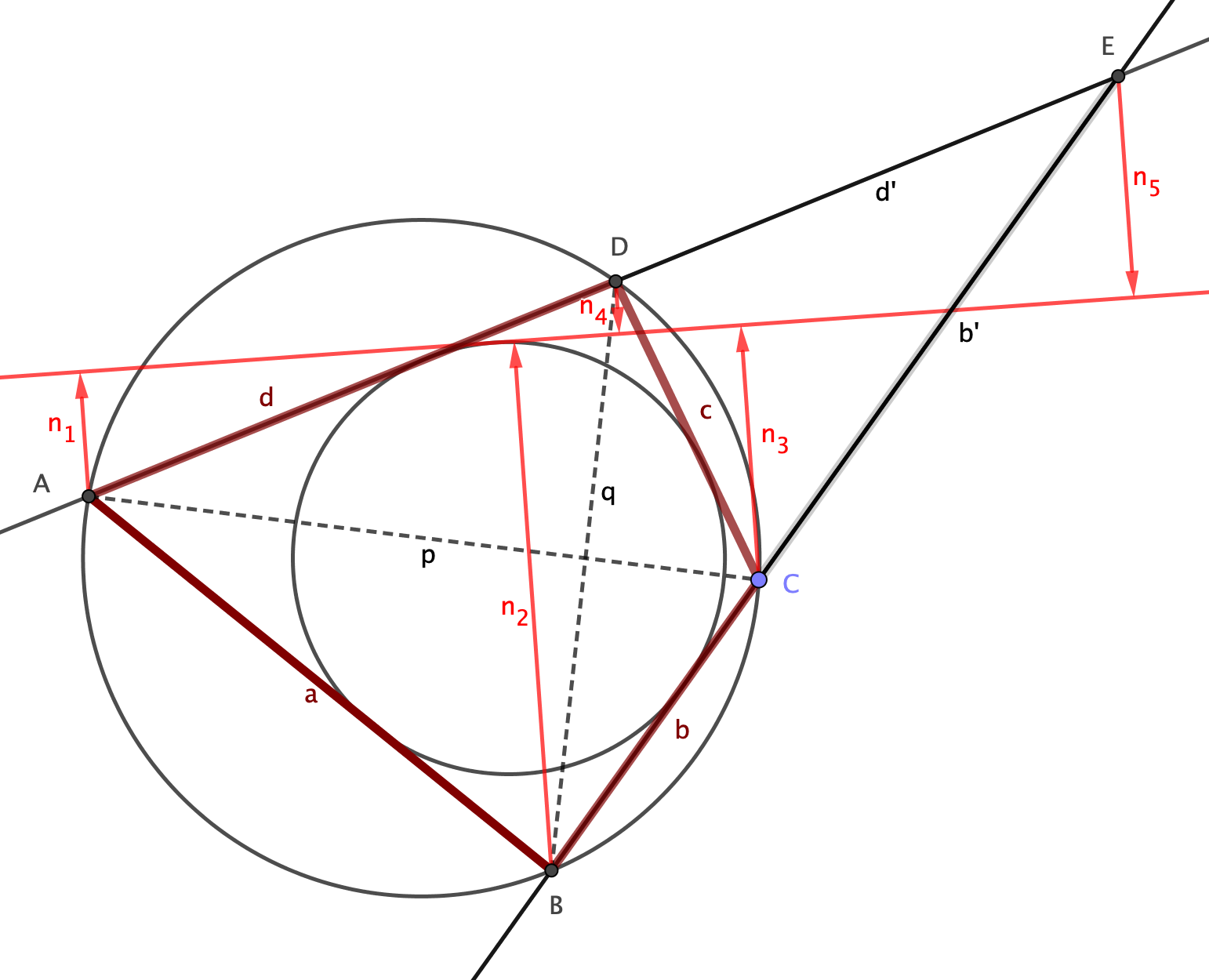A good introduction to Harcourt's theorem can be found in Dergiades and Salazar, Harcourt’s Theorem. In addition, they state and prove a similar theorem in reference to the excircles of the triangle. We'll use that here.
Extend lines $AB$ and $BC$ to their intersection $E$. We refer to $d'$ and $b'$ are the lengths of the segments $DE$ and $CE$ as $d'$ and $b'$ respectively. The signed difference $n_5$ is the signed distance of $E$ to the tangent. $n_5$, and can be calculated using congruent triangles in two ways:
$$ \begin{aligned} n_5 &= n_3+\frac{b'}{b}(n_3-n_2) \\ n_5 &= n_4+\frac{d'}{d}(n_4-n_1) \end{aligned}\tag{*} $$ orand any weighted sum thereof.
because the quadrilateral $ABCD$ is tangential, $a+c=b+d$. In particular the semiperimeter $s=b+d$.
because $ABCD$ is cyclic, the triangles $EDB$ and $ECB$ are similar. Thus $\cfrac{p}{q}=\cfrac{b'}{d'}=\cfrac{d+d'}{b+b'}$. We can see that the ratio $p/q$ is echoed in other parts of the diagram. The formula for area that is to be proven is the product of semiperimeter and a $p:q$ weighted sum of the $n_i$'s. Since $s=b+d$ and $d+d'-b':b+b'-d'=p:q$ we can rewrite the formula as follows.
$$ \begin{aligned} 2K &= \cfrac{s}{p+q}(q(n_1+n_3)+p(n_2+n_4) \\ &= \cfrac{b+d}{d+d'-b'+b+b'-d'}(b+b'-d')(n_1+n_3)+(d+d'-b')(n_2+n_4) \\ &= (b+b'-d')(n_1+n_3)+(d+d'-b')(n_2+n_4).\qquad \qquad (1) \end{aligned} $$
- Let $K$ be the area of $ABCD$ and $K'$ be the area of $EDC$. The incircle of $ABCD$ is also the incircle of $ABE$ and an excircle of $EDC$. By Harcourt's Theorem and the excircle theorem in the reference we can calculate areas:
$$ \begin{aligned} 2(K+K')&=an_5+(b+b')n_1+(d+d')n_2 \\ 2K'&= -cn_5+b'n_4+d'n_3 \\ 2K &= (a+c)n_5+(b+b')n_1+(d+d')n_2-d'n_3-b'n_4 \\ &= (b+d)n_5+(b+b')n_1+(d+d')n_2-d'n_3-b'n_4 \qquad \qquad (2) \\ \end{aligned} $$
Then let $n_5$ be the weighted sum (using (*) and weights $d,b$ ) $$ \cfrac{d(n_4+\cfrac{d'}{d}(n_4-n_1))+b(n_3+\cfrac{b'}{b}(n_3-n_2))}{b+d} $$
Then plug this into (2) and simplify (I used Mathematica) to get
$$ 2K=(b+b'-d')(n_1+n_3)+(d+d'-b')(n_2+n_4), $$
which we showed earlier (1) was equivalent to the OP formula.

